|
The Film

Big Trouble in Little China (John Carpenter, 1986)
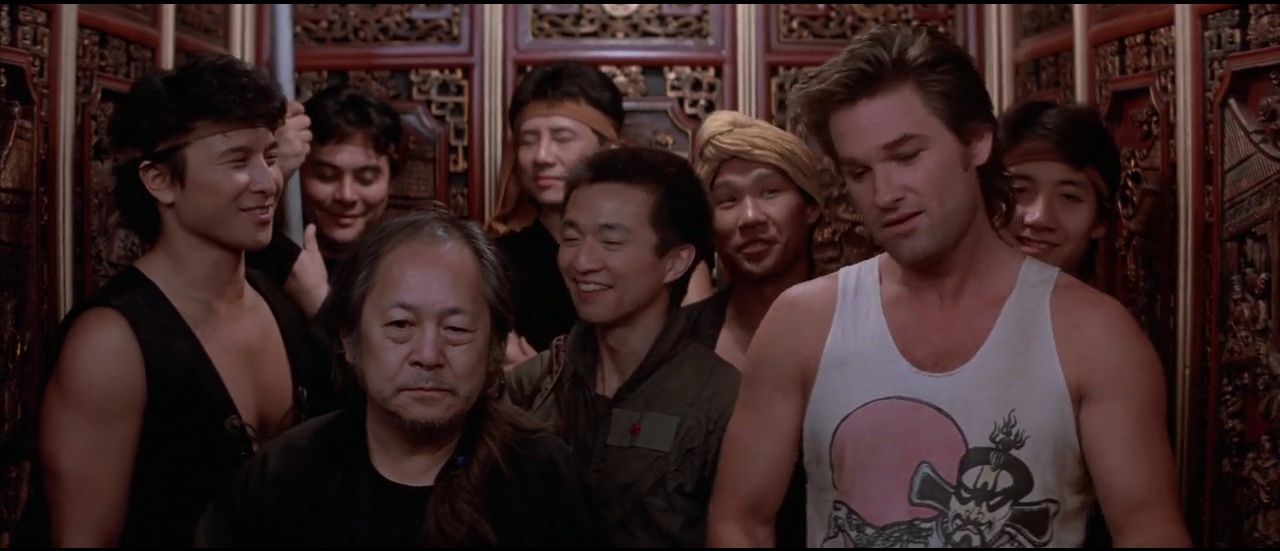 A major flop on its original release, John Carpenter’s Big Trouble in Little China has since found a niche audience on various home video formats. A mélange of various genres (action picture, martial arts film, ‘buddy’ caper, science fiction), Big Trouble in Little China was met with bewilderment by both audiences and studio executives who, Carpenter asserts in one of the interviews contained on this disc, initially demanded that Carpenter cut many of the film’s moments of humour before, at the last minute, requesting that he reinstate them. Colin Odell and Michelle Le Blanc have argued that the confused response to the film was down to the fact that Big Trouble in Little China ‘was just too far ahead of its time’ (2011: np). Aside from the conventions of traditional martial arts films, Carpenter’s picture referenced the more outré conventions of Hong Kong’s Cat III pictures: there are a number of parallels, both in terms of effects and narrative, between Carpenter’s film and Ngai Choi Lam’s eccentric Cat III shocker The 7th Curse (1986). As Odell and Le Blanc note, Hong Kong films had ‘moved on from those “you killed my sifu” days of the 1970s and was producing some of the most intense and exciting cinema in the world’, but the vast majority of these films were accessible only to ‘die-hard cineastes and fanatics’ (ibid.). Consequently, on its initial release Big Trouble in Little China was met with bemusement, but as the home video era made some of its more outrageous reference points accessible to a wider audience, it acquired a strong cult following. A major flop on its original release, John Carpenter’s Big Trouble in Little China has since found a niche audience on various home video formats. A mélange of various genres (action picture, martial arts film, ‘buddy’ caper, science fiction), Big Trouble in Little China was met with bewilderment by both audiences and studio executives who, Carpenter asserts in one of the interviews contained on this disc, initially demanded that Carpenter cut many of the film’s moments of humour before, at the last minute, requesting that he reinstate them. Colin Odell and Michelle Le Blanc have argued that the confused response to the film was down to the fact that Big Trouble in Little China ‘was just too far ahead of its time’ (2011: np). Aside from the conventions of traditional martial arts films, Carpenter’s picture referenced the more outré conventions of Hong Kong’s Cat III pictures: there are a number of parallels, both in terms of effects and narrative, between Carpenter’s film and Ngai Choi Lam’s eccentric Cat III shocker The 7th Curse (1986). As Odell and Le Blanc note, Hong Kong films had ‘moved on from those “you killed my sifu” days of the 1970s and was producing some of the most intense and exciting cinema in the world’, but the vast majority of these films were accessible only to ‘die-hard cineastes and fanatics’ (ibid.). Consequently, on its initial release Big Trouble in Little China was met with bemusement, but as the home video era made some of its more outrageous reference points accessible to a wider audience, it acquired a strong cult following.
The film concerns trucker Jack Burton (Kurt Russell) and his friend, former trucker-turned-restaurant-owner Wang (Dennis Dun). After a all-night gambling session in San Francisco’s Chinatown, which ends with Wang owing Burton a considerable amount of money, Burton offers to drive Wang to the restaurant Wang owns, so that Burton may collect his winnings. On the way, the pair make a stop at the airport to collect Wang’s fiancée Miao Yin (Suzee Pai), who is flying in to America from Hong Kong. However, Miao Yin is abducted by the Lords of Death, a Chinese-American street gang. Wang and Burton pursue the Lords of Death but find themselves caught up in a battle between the Lords of Death and the Chang Sing, a rival street gang; this confrontation is interrupted by the arrival of the Three Storms, mythical beings who in ancient Chinese folklore acquired magical skills enabling them to control the elements. The Three Storms are accompanied by Chinese sorcerer Lo Pan (James Hong); attempting to flee from the scene, Burton seems to run over Lo Pan with his truck, the Pork Chop Express. However, exiting the truck Burton and Wang notice that Lo Pan is miraculously uninjured. A display of this ancient sorcerer’s power causes Wang and Burton to flee on foot, leaving the Pork Chop Express behind. Wang and Burton enlist the help of lawyer Gracie Law (Kim Cattrall), Wang’s friend Eddie Lee (Donald Li) and the mysterious Egg Shen (Victor Wong); Shen informs Wang and Burton that Lo Pan intends to marry and sacrifice Miao Yin in a ceremony that will provide this already 2000 year old sorcerer with an expanded lifespan. Using the skills of the Chang Sing, with whom Egg Shen is affiliated, the group infiltrate Lo Pan’s headquarters and, encountering various magical traps and monsters, attempt to rescue Maio Yin from certain death.
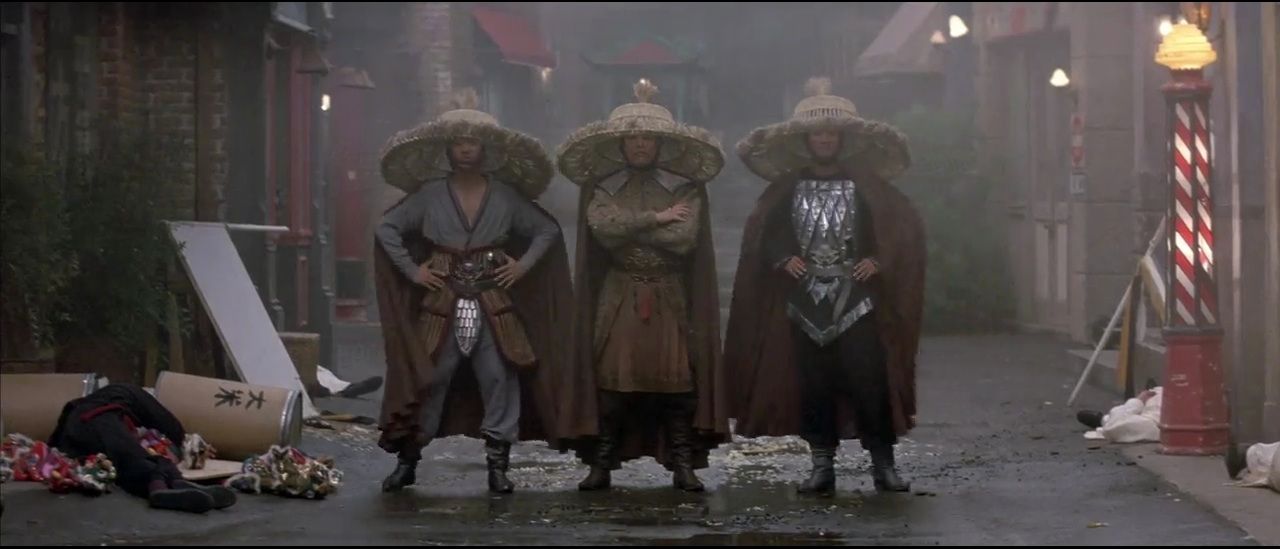 Big Trouble in Little China’s hodgepodge of influences, Odell and Le Blanc argue, include Mike Hodges’ Flash Gordon (1980), the ‘hyperkinetic’ stuntwork and effects of films like Tsui Hark’s Zu: Warriors from the Magic Mountain (1983), and Japanese filmmaker Kenji Misumi’s Lone Wolf and Cub films of the 1970s - specifically, the iconography of the Three Storms, though the characters themselves are based on ancient Chinese mythology, draws on the depiction of the Masters of Death in Misumi’s Baby Cart at the River Styx (1972), the second film in the Lone Wolf and Cub series. (Jack Burton’s desire to regain his stolen truck also recalls the 1980 West German film Theo Against the Rest of the World/Theo gegen den Rest der Welt, directed by Peter F Bringmann, in which the protagonist tracks his stolen truck through Europe, whilst himself being chased by his creditors.) The film was released in an era in which American films were showing an increasing interest in Asian American cultures and were referencing the conventions of Asian cinemas: films such as The Karate Kid (John G Avildsen, 1984) and Showdown in Little Tokyo (Mark L Lester, 1991) referenced the conventions of Asian martial arts films and reframed them within the context of Hollywood action cinema, whilst pictures like The Year of the Dragon (Michael Cimino, 1985), China Girl (Abel Ferrara, 1987) and The King of New York (Abel Ferrara, 1990) examined Asian cultures within America. Big Trouble in Little China’s hodgepodge of influences, Odell and Le Blanc argue, include Mike Hodges’ Flash Gordon (1980), the ‘hyperkinetic’ stuntwork and effects of films like Tsui Hark’s Zu: Warriors from the Magic Mountain (1983), and Japanese filmmaker Kenji Misumi’s Lone Wolf and Cub films of the 1970s - specifically, the iconography of the Three Storms, though the characters themselves are based on ancient Chinese mythology, draws on the depiction of the Masters of Death in Misumi’s Baby Cart at the River Styx (1972), the second film in the Lone Wolf and Cub series. (Jack Burton’s desire to regain his stolen truck also recalls the 1980 West German film Theo Against the Rest of the World/Theo gegen den Rest der Welt, directed by Peter F Bringmann, in which the protagonist tracks his stolen truck through Europe, whilst himself being chased by his creditors.) The film was released in an era in which American films were showing an increasing interest in Asian American cultures and were referencing the conventions of Asian cinemas: films such as The Karate Kid (John G Avildsen, 1984) and Showdown in Little Tokyo (Mark L Lester, 1991) referenced the conventions of Asian martial arts films and reframed them within the context of Hollywood action cinema, whilst pictures like The Year of the Dragon (Michael Cimino, 1985), China Girl (Abel Ferrara, 1987) and The King of New York (Abel Ferrara, 1990) examined Asian cultures within America.
Like a number of these films, Big Trouble in Little China was criticised for its allegedly negative depiction of Asian American communities. In Hollywood’s Representations of the Sino-Tibetan Conflict (2012), Jenny Daccache and Brandon Valeriano suggest that in Lo Pan, Big Trouble in Little China ‘pinpoints the enemy as an exact Fu Manchu-type villain while declaring that China is the source of evil’ (71). Citing Selma Bidlingmaier’s comments about the film, Daccache and Valeriano argue that the film’s very title reinforces the perception of China and Chinese culture as an ‘Other’, and this ‘is further reinforced in the movie by Uncle Chu’s insistence that “China is here” and that Tong’s [sic] have brought their evil to Chinatown’ (Biglingmaier, quoted in ibid.). Daccache and Valeriano suggest that the film represents Chinatown as ‘the source of evil in the city […] a mysterious and mystical place to be defeated by the American hero’ (ibid.).
However, this summary of the film arguably sidesteps Big Trouble in Little China’s ironic depiction of Jack Burton. Carpenter has commented that Burton is not really the ‘hero’ of the film: he is instead Wang’s sidekick or ‘helper’, although Burton perceives himself to be an undisputable hero. His arrogance is highlighted in the scene that introduces him, where he is shown driving the Pork Chop Express into San Francisco and dispensing homegrown ‘wisdom’ via his CB radio (‘Like I told my last wife […] I never drive faster than I can see. Besides that, it’s all in the reflexes’). Burton is brusque and hubristic, a walking embodiment of macho bravado. He misses most of the climactic fight between the Lords of Death and the Chang Sing: entering the room in which the battle takes place, Burton fires his machine pistol above his head, causing part of the stone archway directly above him to splinter, fall and knock him unconscious. Later, his final confrontation with Lo Pan is preceded by a scene in which he and Gracie Law ascend to Lo Pan’s chambers via an elevator. In the elevator, they embrace and kiss; the sole function of this scene seems to be so that Burton confronts Lo Pan with the ridiculous, feminising sight of Gracie’s bright red lipstick smeared across his lips. (At the end of the film, Carpenter frustrates Hollywood conventions when, after Miao Yin has been successfully rescued, Burton leaves Wang and the rest of the group. ‘Aren’t you even going to kiss her goodbye?’, Gracie’s friend asks Burton, referring to Gracie. ‘No’, Burton responds, walking out of the door.)
 Carpenter himself has said that one of the reasons why the studio were so bemused by the film was because it was about a Caucasian character who thinks he’s the hero but is in fact little more than a sidekick (see the Carpenter interview on this Blu-ray). In fact, Fox were reputedly so perplexed by Carpenter’s handling of Burton that they forced him to shoot a prologue in which Egg Shen explains to a lawyer (Jerry Hardin) that Burton is ‘a hero’, before providing a demonstration of Chinese sorcery. (When the lawyer asks Shen why he is expected to believe in sorcery, Shen replies, ‘Because it’s real’.) Likewise, David West has stated that whilst Big Trouble in Little China ‘treats the Chinese magical elements of the story with respect’, most of the film’s ‘humour comes from the treatment of the character of Jack Burton’ (2006: 232). Through Burton, Carpenter ‘parodies the American hero’; the character is a ‘macho trucker’ who is ‘consistently diminished within the narrative’ (ibid.). Burton is ‘constantly robbed of his dignity where the Chinese heroes are allowed to keep theirs intact’: West concludes that this approach is atypical for a Hollywood film, ‘where Caucasians are invariably the heroes and non-whites either sidekicks or villains, but [it] illustrates that Carpenter’s approach is based on a respect for Chinese culture’ (ibid.). Carpenter himself has said that one of the reasons why the studio were so bemused by the film was because it was about a Caucasian character who thinks he’s the hero but is in fact little more than a sidekick (see the Carpenter interview on this Blu-ray). In fact, Fox were reputedly so perplexed by Carpenter’s handling of Burton that they forced him to shoot a prologue in which Egg Shen explains to a lawyer (Jerry Hardin) that Burton is ‘a hero’, before providing a demonstration of Chinese sorcery. (When the lawyer asks Shen why he is expected to believe in sorcery, Shen replies, ‘Because it’s real’.) Likewise, David West has stated that whilst Big Trouble in Little China ‘treats the Chinese magical elements of the story with respect’, most of the film’s ‘humour comes from the treatment of the character of Jack Burton’ (2006: 232). Through Burton, Carpenter ‘parodies the American hero’; the character is a ‘macho trucker’ who is ‘consistently diminished within the narrative’ (ibid.). Burton is ‘constantly robbed of his dignity where the Chinese heroes are allowed to keep theirs intact’: West concludes that this approach is atypical for a Hollywood film, ‘where Caucasians are invariably the heroes and non-whites either sidekicks or villains, but [it] illustrates that Carpenter’s approach is based on a respect for Chinese culture’ (ibid.).
For Carpenter, Burton is ‘a sort of a John Wayne without a clue’ (see the Carpenter interview on this Blu-ray). This was the fourth of the collaborations between actor Kurt Russell and director John Carpenter, following the television biopic Elvis (1978), Escape from New York (1981) and The Thing (1982). Russell and Carpenter would collaborate once more, on Escape from LA (1996). Parallels have sometimes been drawn between the working relationship between Carpenter and Russell and that between John Wayne and Howard Hawks. (Carpenter’s Assault on Precinct 13, 1976, was a veiled modernisation of Hawks’ 1959 Western Rio Bravo; Carpenter edited Precinct 13 himself, under the pseudonym John T Chance, which is also the name of Wayne’s character in Rio Bravo.) Carpenter’s films often employ the snappy quickfire dialogue that Hawks made famous in his screwball comedies, such as Bringing Up Baby (1938): this is evident throughout Big Trouble in Little China, especially in the dialogue between Burton and Gracie Law. (Cattrall does a particularly fine job of handling this rapid exchange of dialogue, delivering her dialogue in a breathy voice that recalls Hollywood stars of the 1930s, 1940s and 1950s.) Like Wayne’s appearances in Hawks’ films, Russell’s performances in Carpenter’s pictures ran the gamut from the dramatic (The Thing) to the comic (Big Trouble in Little China). In Escape from New York, Russell’s performance as Snake Plissken offered a pastiche of Clint Eastwood’s distinctive whispered voice and ‘tight-lipped’ delivery in his role as Harry Callahan (Dirty Harry, Don Siegel, 1971). Likewise, Russell’s performance in Big Trouble in Little China references Wayne directly, ‘right down to the drawling delivery and slouching, lumbering gait’ (Shail, 2004: 108). Russell’s final moment, in which he walks away from Gracie Law, has been interpreted as a parody of the closing scene of John Ford’s The Searchers (1956), in which Wayne’s Ethan Edwards walks away from his family’s homestead after rescuing his niece from Comanches. Citing Yvonne Tasker’s work, Robert Shail notes that this ‘myth deflating’ moment at the close of Big Trouble in Little China has corollaries in other Russell performances, such as the sequence in Tango and Cash (Andrey Konchalovskiy, 1989) in which Russell’s character appears in drag (ibid.: 113).
Video
The last Carpenter film to be shot by one-time frequent Carpenter collaborator Dean Cundey, Big Trouble in Little China is filled with the trademarks of Cundey’s cinematography for Carpenter’s films: the use of wide-angle lenses, prowling Steadicam tracking shots. These traits would be carried over to the films Gary Kibbe later shot for Carpenter (for example, Prince of Darkness, 1987).
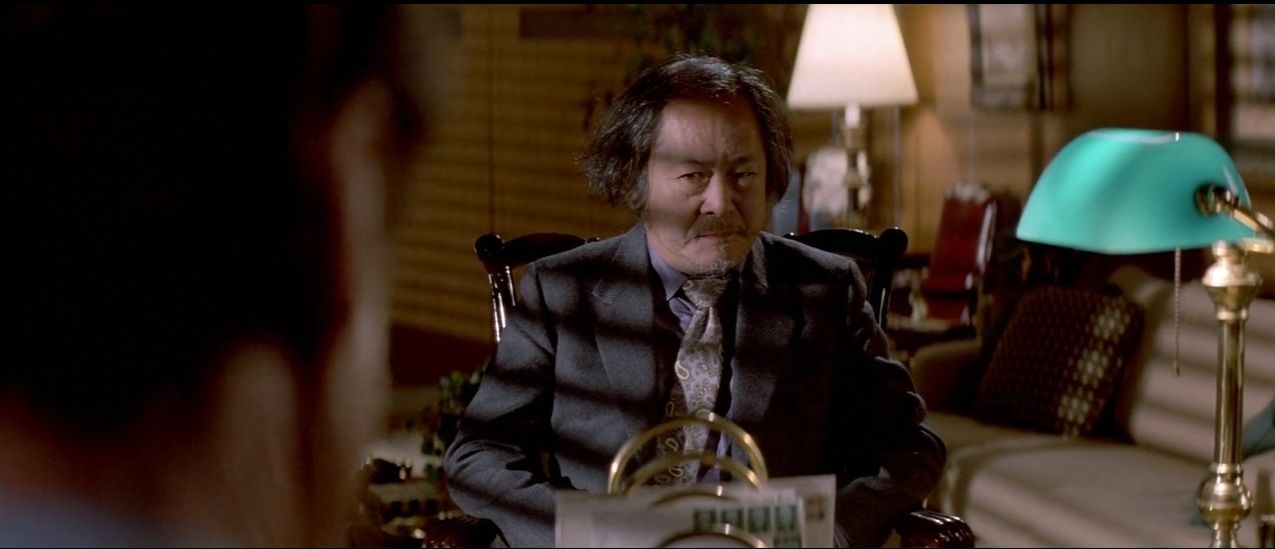 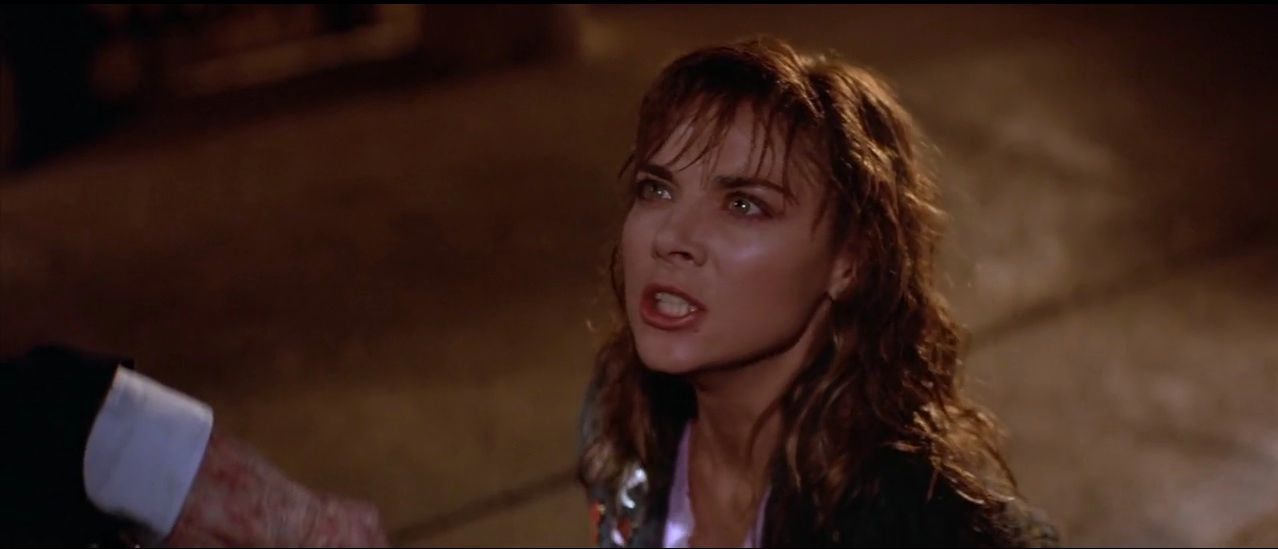
This is the same transfer of the film as was showcased on the US Blu-ray released by Fox several years ago, although here it is presented via a slightly more robust encode (via the AVC codec). The 1080p presentation is in the film’s theatrical aspect ratio of 2.35:1; a direct comparison with the US Blu-ray shows that the Arrow presentation is very slightly cropped on both right and left-hand sides of the frame. As this is an ‘inherited’ transfer, it displays the same characteristics as the release from Fox: although for the most part edge enhancement isn’t a problem, some of the more brightly lit scenes evidence slight ‘ringing’. On the other hand, contrast is strong and the transfer contains a very good representation of the film’s varied colour palette (the drab colours of Chinatown contrasting with the vibrant colours of Lo Pan’s temple). There’s much low light photography here too, and the transfer shows the level of grain that one would expect to see from a film shot under such conditions: in other words, it’s a natural, filmlike transfer. In sum, this is the best presentation of the film currently available on home video, easily eclipsing the previous DVD releases and edging ahead of the US Blu-ray.
The disc is encoded for playback in region ‘B’ machines only.
Audio
Aside from an isolated music and effects track, there are two audio options: an English DTS-HD Master Audio 5.1 track and an English LPCM 2.0 surround track. Both are fine and clear, although the LPCM surround track is deeper with more resonant bass; this is especially noticeable in sequences that feature the film’s score or those in which gunfire can be heard on the audio track. By contrast, I found the 5.1 track slightly ‘hollow’ and less satisfying, but still commendable nonetheless.
Optional English HoH subtitles are present on the disc.
Extras
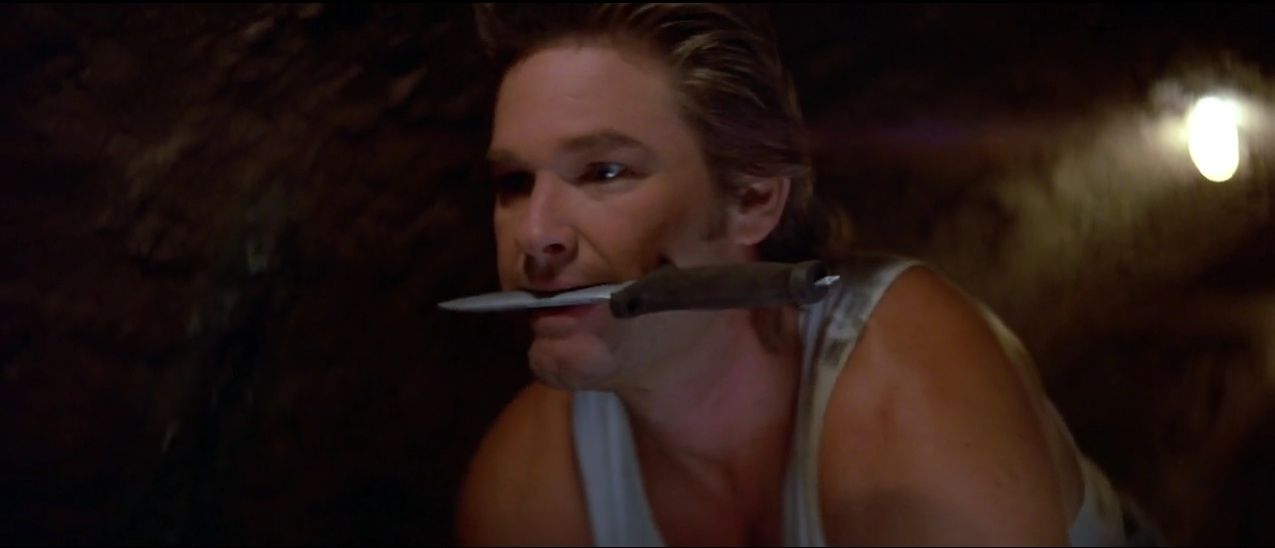 The disc includes all of the contextual material from the US Blu-ray, with some newly-created extras too. (Extras exclusive to the Arrow release are marked in bold font below.) The disc includes all of the contextual material from the US Blu-ray, with some newly-created extras too. (Extras exclusive to the Arrow release are marked in bold font below.)
The Blu-ray includes:
- An audio commentary with Carpenter and Kurt Russell;
- A DTS-HD Master Audio 5.1 isolated score track;
- A ‘making of’ featurette made during the production of the film (7:28);
- An extended ending to the film (3:17);
- A number of deleted scenes
-- ‘Airport’, presented in both a workprint edit (5:57) and an early videotape edit (7:06). As the title suggests, this scene is an extension of the early scene in which Burton and Wang arrive at the airport to collect Miao Yin.
-- ‘The Dragon of the Black Pool’, again available in the version from the workprint (2:46) and as a videotape edit (4:28). This is an extension of the sequence in which Burton telephones his insurance company to report his missing truck.
-- ‘The White Tiger’, also available in its workprint version (2:21) and as a videotape edit (7:14). This sequence revolves around the Lords of Death-operated brothel in which Miao Yin is held.
-- ‘Gracie’s Office’, from the workprint (3:44). Wang, Burton and the others retreat to Gracie Law’s office after their botched attempt at rescuing Miao Yin from the White Tiger.
-- ‘Thunder’s Tour’, from the workprint, features a more detailed examination of the ‘front’ for Lo Pan’s operation, the Wing Kong Exchange (1:39).
-- ‘Beneath Chinatown’, from the workprint, sees Egg Shen explaining more about the mythology surrounding Lo Pan as the group head towards the final confrontation (2:26).
-- The ‘Lava Sequence’, presented via three angles (in its storyboard version; in its filmed version; and with both storyboard and filmed versions on screen together) (1:30).
-- ‘Six Demon Bag’, an assortment of cut scenes and scene extensions from early assemblies of the film (11:55).
- a music video featuring the song ‘Big Trouble in Little China’, which plays over the film’s closing credits. The video features Carpenter, Tommy Lee Wallace and Nick Castle performing the track, intercut with clips from the film (3:28);
- A substantial stills gallery;
- Three different trailers (2:47; 1:32; 2:42) and six TV spots (0:32; 0:32; 0:32; 0:32; 0:31; 1:02; 0:55);
- An interview with visual effects producer Richard Edlund, presented via two angles: this can be watched as a shot of Edlund sitting at his desk, with a slide show presented ‘inset’ into the image; or as a full-screen slide show (13:25)
- ‘Return to Little China’: an interview with John Carpenter (12:16);
- ‘Being Jack Burton’: an interview with Kurt Russell (20:59);
- ‘Carpenter and I’: an interview with Dean Cundey (15:40);
- An interview with Larry Franco (15:23);
- An interview with stunt co-ordinator Jeff Imada (12:32).
Overall
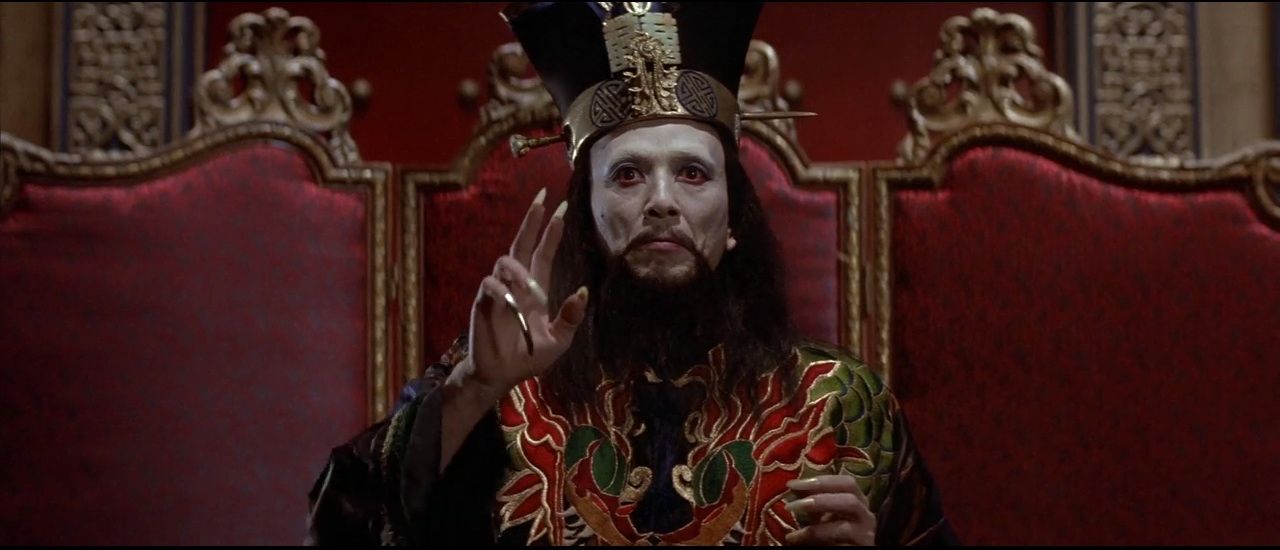 Big Trouble in Little China was originally written (by Gary Goldman and David Weinstein) as a Western set in the 1880s, but was rescripted as a modern-day fantasy by W D Richter, who had recently directed the similarly offbeat The Adventures of Buckaroo Banzai Across the 8th Dimension (1984). Goldman and Weinstein’s original script was intended as a homage to the visually-inventive, manhua (Chinese comic book)-influenced wuxia/swordplay films of the early 1980s, such as Tsui Hark’s Zu: Warriors from the Magic Mountain. This comic book approach is evident throughout the film, which is arguably a clever, and for a long time severely underrated satire of the conventions of the Hollywood action film. This disc contains a very good presentation of the film, definitely the best currently available; it also includes all of the extra features of the US disc, with some new interviews. This release is strongly recommended. Big Trouble in Little China was originally written (by Gary Goldman and David Weinstein) as a Western set in the 1880s, but was rescripted as a modern-day fantasy by W D Richter, who had recently directed the similarly offbeat The Adventures of Buckaroo Banzai Across the 8th Dimension (1984). Goldman and Weinstein’s original script was intended as a homage to the visually-inventive, manhua (Chinese comic book)-influenced wuxia/swordplay films of the early 1980s, such as Tsui Hark’s Zu: Warriors from the Magic Mountain. This comic book approach is evident throughout the film, which is arguably a clever, and for a long time severely underrated satire of the conventions of the Hollywood action film. This disc contains a very good presentation of the film, definitely the best currently available; it also includes all of the extra features of the US disc, with some new interviews. This release is strongly recommended.
References:
Dacccache, Jenny George & Valeriano, Brandon, 2012: Hollywood’s Representations of the Sino-Tibetan Conflict: Politics, Culture, and Globalization. London: Palgrave MacMillan
Odell, Colin & Le Blanc, Michelle, 2011: John Carpenter. Kamera Books
Shail, Robert, 2004: ‘Masculinity, Kurt Russell and the Escape films’. In: Conrich, Ian & Woods, David (eds), 2004: The Cinema of John Carpenter: The Technique of Terror. London: Wallflower Press: 107-117
West, David, 2006: Chasing Dragons: An Introduction to the Martial Arts Film. London: I B Tauris
| The Film: |
Video: |
Audio: |
Extras: |
Overall: |
|


